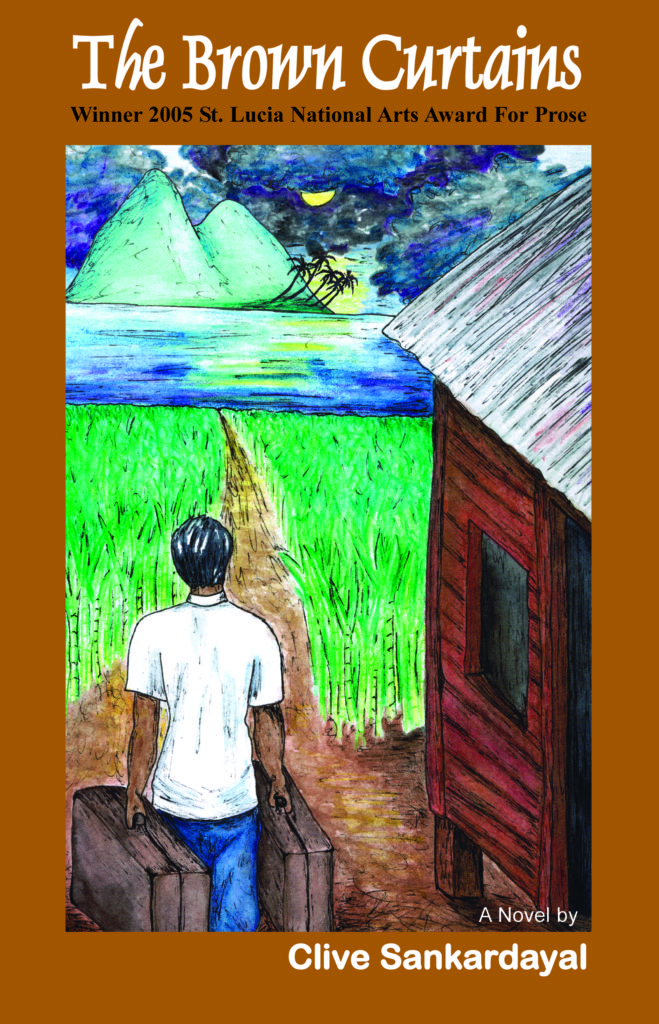
ISBN-10: 0970443250
ISBN-13: 978-0970443250
Format: Trade Paperback Pages: 288 pp.
Pub. Date: January 2006
Publisher: Jako Books
Awards: Winner 2005 National Arts Award for Prose
Short Listed for the 2006 Guyana Prize for best Fiction
 From The Publisher
From The Publisher
What happens in The Brown Curtains when a group of Guyanese professionals migrate to St. Lucia to take advantage of better pay, presents a lesson in racial, cultural and religious tolerance that has important implications for the CSME and Caribbean integration.
As one of the few West Indian novels to explore intra Caribbean migration and cultural differences among CARICOM countries, The Brown Curtains is indeed a path making work of art. At its core, the novel embroils readers in a steaming love story involving Raj, an Indo-Guyanese emigrant to St. Lucia, and Felicity, a St. Lucian black beauty. The only question is whether their love can withstand the racial and religious bigotry of Raj’s parents.
Praise for The Brown Curtains
“A novel of great humor, and philosophical and political insight.”
— Allan Weekes, Author of Talk of the Devil
“A powerful commentary on race, culture and religion, and the uncompromising influence of love… an insightful, persuasive and entertaining work of art … Sankardayal has succeeded in producing a work of genius.” — Modeste Downes, Author of Phases
“Whether you are Black, Indian, Christian, Hindu or Moslem, The Brown Curtains gently goads you in the direction of forgotten trails and alleys of the diaspora. It is a novel for everyone because it shows that adapting to a new life is the same wherever you arrive.”
— Michael Aubertin, Author of Neg Maron: Freedom Fighters
Reviews
Modeste Downes
author of Phases and Theatre of the Mind
In this his debut novel, Sankardayal has succeeded in crafting a work of genius. His portrayal of the racial disharmony that has characterized his homeland, Guyana, is mirrored glaringly in the daring of a young Indo-Guyanese emigrant to a neighboring Caribbean island as he breaks with tradition by taking a Black (African) bride. It is a little story of a huge problem told by someone who has encountered a new reality of social integration that calls into question the sanity of old customs—”You fossilized piece of shit” as Raj refers to a fellow emigrant in a fit of rage.
Indeed, Sankardayal has produced an insightful, persuasive and entertaining work of art. His narrative skills, characterization and purposefulness combine to make this book a must-read for all racial strands, especially the people of Indian and African culture who inhabit these islands of the archipelago (or elsewhere in the diaspora).
The Brown Curtains is a powerful, scholarly and critical commentary on race, culture and religion and the uncompromising influence of love.
Frank Birbalsingh, Emeritus Professor
Although the action in Clive Sankardayal’s The Brown Curtains is neither chiefly nor explicitly concerned with politics, or indeed with Guyana, it is strange that the novel should yield such an accurate portrait of Guyanese politics during the 1960s, when a pattern of political dictatorship and economic decline was established, leading to general breakdown and the headlong flight of tens of thousands of Guyanese as immigrants in foreign lands.
Since then, as we know, many fictional portraits have emerged of Guyanese immigrants chiefly in Britain, in Canada and the US, for example, by authors such as Fred D’Aguiar, Cyril Dabydeen and Brenda Do Harris. But Guyanese settled in the Caribbean too after 1960, albeit in smaller numbers than they did in Britain and North America; and it is the gap created by their relative absence in fiction that The Brown Curtains now fills with its record of Indo-Guyanese immigrants in St. Lucia.
Ronald Singh, the narrator of The Brown Curtains is a Guyanese school teacher who migrates to St. Lucia along with three friends: Rajendra Girdharry (Raj), Bramnarine Tiwari (Bram), and Narendra Chatterpaul (Bram).
According to Ron, life in his West Coast Demerara village was not bad until the early 1960s when: “politically instigated race riots, pitting Indian against Africans, forever changed Zeelugt.” (p.18). What is worse is that the riots: “spread over the land rapidly and destroyed the social fabric of society.” (p.18.) It was a kind of ethnic cleansing in which one ethnic group: “was forced to exchange dwellings and settle in a community of their own race for the safety of their families.”(pp.18-19) Migration was also driven by widespread bribery and corruption in government and “kick down the door robbery.” (p.31)
The preferred destinations for Guyanese fleeing such conditions were metropolitan centers in North America, but as we see from The Brown Curtains, West Indian islands like St. Lucia (and Barbados) were chosen as second best, and sometimes as stepping stones to the Shangri-la of cities like New York or Toronto.
Ron and his friends settle smoothly in Mon Repos, St. Lucia, getting jobs and living together in a rented house with brown curtains while they buy groceries from Regis, a local entrepreneur, who uses his premises to stage films and other forms of entertainment, including cockfighting.
The four friends reflect on their families at home and reminisce about their homeland, but they relish the absence of fear and tension that they have left behind.
They play dominoes and cricket, while their main social contact, with Regis, is more business-like than social.
Only Raj, the youngest of the four Guyanese friends, mixes socially, and he soon gets a St. Lucian girlfriend named Felicity.
But by that time the school holidays arrive, relations with Regis turn sour, and Ron who teaches at Soufriere Comprehensive School returns to Guyana for a visit along with Bram and Nar. The somewhat meandering action of the first half of the novel picks up steam from the start of the school holidays in its second half.
First, there is the excitement, joy, and banter of Ron’s reunion with his wife Geetangali (Geet) and their children, and their attendance at an Easter fête with loud music, kite flying and activities such as climbing the greasy pole.
“Women and children sat carelessly and rocked to the blare of Indian music…Man, box, bird, diamond shaped and star pointed kites claimed the air and darted to and fro crazily. (p.176) More importantly, news of Raj’s relationship with Felicity hits the Indian village of Zeelugt with the impact of a tsunami.
From every quarter Ron is confronted by dark hints, suspicion and fear-filled mutterings: “I hear Girdo son [Raj] living with a black girl? True?” (p.185) Nor does Raj’s father Girdharry leave any doubt about his village’s unease when he candidly admits: “If Raj marry a black girl he go put me to shame.” (p.190)
To prevent this calamity Girdharry arranges a marriage for Raj with the daughter of Ramroop, a rich shopkeeper. He also pleads with Raj: “If was an Indian no matter she not Hindu, we woulda come around, but a black girl! My God, Lord Krishna! Why you punish me so, Raj? Is obeah they obeah you?” (p.264) But it is all in vain for Raj goes ahead anyway and marries Felicity.
Yet this victory of true love is more apparent than real since the novel ends with a discussion of Raj’s marriage between Ron and Mr. Girdharry in which the narrator feels a burning pain: “as if a centipede had just sunk its poisonous mandibles into my [his] flesh.” (288)
This final image confirms that although the view of Zeelugt villagers – that inter-racial union is a calamity – does not prevail in The Brown Curtains, it is too deeply ingrained to be ignored; for it is, at least partly, the product of race relations that have been deeply poisoned by Guyanese politics.
Still, there is much in The Brown Curtains that encourages us to see Raj’s marriage as a sign that divisions of race, class, colour, religion and so on are beginning to lose some of the power they once had in the Caribbean.
After all, the novel is awash in the raw, coarse and bawdy humour of dialogue which is mother’s milk to all West Indians, and which is conspicuous both in the Guyanese Easter fête already mentioned, and in the Gros Islet street jam that follows later in St. Lucia. There are also numerous cricket games in The Brown Curtains.
Not for nothing did The Brown Curtains win the St. Lucia National Arts Award for Prose in 2005 – a signal honour for a Guyanese author whose characters, despite differences of race, religion, and diet, settle with surprising ease into St. Lucian society.
No wonder the novel is announced on its back cover as: “one of the few West Indian novels to explore intra-Caribbean migration and cultural differences among CARICOM countries. “ It is groundbreaking exploration [of a society in flux, of a people in transition].
![]()
